X. Li
Los Alamos National Laboratory
CSTrack: Enhancing RGB-X Tracking via Compact Spatiotemporal Features
May 26, 2025Abstract:Effectively modeling and utilizing spatiotemporal features from RGB and other modalities (\eg, depth, thermal, and event data, denoted as X) is the core of RGB-X tracker design. Existing methods often employ two parallel branches to separately process the RGB and X input streams, requiring the model to simultaneously handle two dispersed feature spaces, which complicates both the model structure and computation process. More critically, intra-modality spatial modeling within each dispersed space incurs substantial computational overhead, limiting resources for inter-modality spatial modeling and temporal modeling. To address this, we propose a novel tracker, CSTrack, which focuses on modeling Compact Spatiotemporal features to achieve simple yet effective tracking. Specifically, we first introduce an innovative Spatial Compact Module that integrates the RGB-X dual input streams into a compact spatial feature, enabling thorough intra- and inter-modality spatial modeling. Additionally, we design an efficient Temporal Compact Module that compactly represents temporal features by constructing the refined target distribution heatmap. Extensive experiments validate the effectiveness of our compact spatiotemporal modeling method, with CSTrack achieving new SOTA results on mainstream RGB-X benchmarks. The code and models will be released at: https://github.com/XiaokunFeng/CSTrack.
Intelligent experiments through real-time AI: Fast Data Processing and Autonomous Detector Control for sPHENIX and future EIC detectors
Jan 08, 2025Abstract:This R\&D project, initiated by the DOE Nuclear Physics AI-Machine Learning initiative in 2022, leverages AI to address data processing challenges in high-energy nuclear experiments (RHIC, LHC, and future EIC). Our focus is on developing a demonstrator for real-time processing of high-rate data streams from sPHENIX experiment tracking detectors. The limitations of a 15 kHz maximum trigger rate imposed by the calorimeters can be negated by intelligent use of streaming technology in the tracking system. The approach efficiently identifies low momentum rare heavy flavor events in high-rate p+p collisions (3MHz), using Graph Neural Network (GNN) and High Level Synthesis for Machine Learning (hls4ml). Success at sPHENIX promises immediate benefits, minimizing resources and accelerating the heavy-flavor measurements. The approach is transferable to other fields. For the EIC, we develop a DIS-electron tagger using Artificial Intelligence - Machine Learning (AI-ML) algorithms for real-time identification, showcasing the transformative potential of AI and FPGA technologies in high-energy nuclear and particle experiments real-time data processing pipelines.
Enhancing Vision-Language Tracking by Effectively Converting Textual Cues into Visual Cues
Dec 27, 2024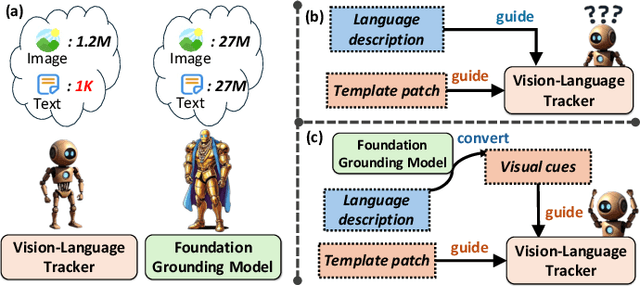
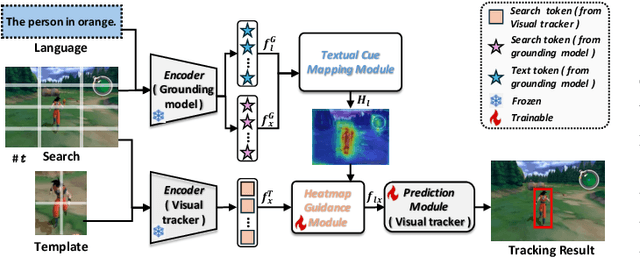
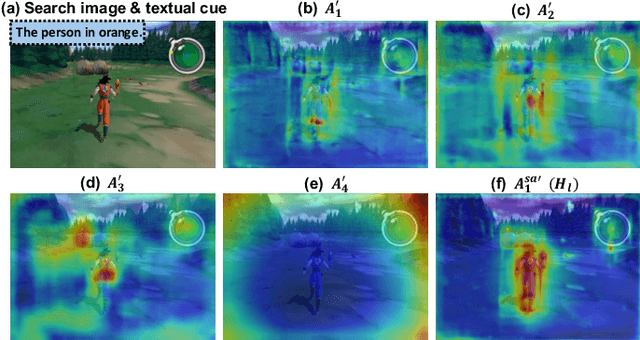
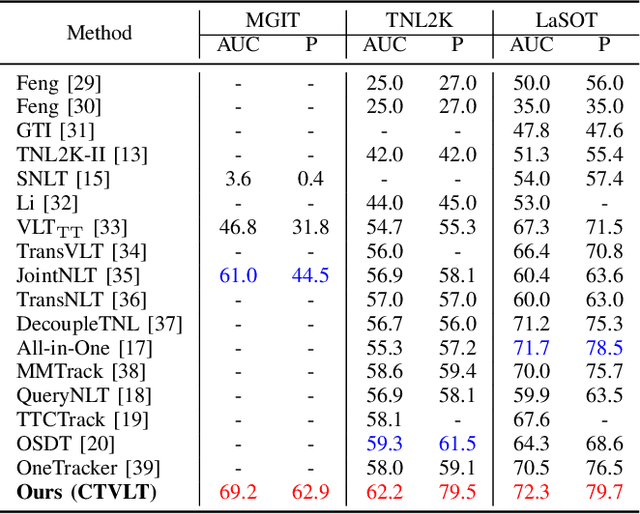
Abstract:Vision-Language Tracking (VLT) aims to localize a target in video sequences using a visual template and language description. While textual cues enhance tracking potential, current datasets typically contain much more image data than text, limiting the ability of VLT methods to align the two modalities effectively. To address this imbalance, we propose a novel plug-and-play method named CTVLT that leverages the strong text-image alignment capabilities of foundation grounding models. CTVLT converts textual cues into interpretable visual heatmaps, which are easier for trackers to process. Specifically, we design a textual cue mapping module that transforms textual cues into target distribution heatmaps, visually representing the location described by the text. Additionally, the heatmap guidance module fuses these heatmaps with the search image to guide tracking more effectively. Extensive experiments on mainstream benchmarks demonstrate the effectiveness of our approach, achieving state-of-the-art performance and validating the utility of our method for enhanced VLT.
Latency Minimization for IRS-enhanced Wideband MEC Networks with Practical Reflection Model
Jul 15, 2024



Abstract:Intelligent reflecting surface (IRS) has been considered as an efficient way to boost the computation capability of mobile edge computing (MEC) system, especially when the communication links is blocked or the communication signal is weak. However, most existing works are restricted to narrow-band channel and ideal IRS reflection model, which is not practical and may lead to significant performance degradation in realistic systems. To further exploit the benefits of IRS in MEC system, we consider an IRS-enhanced wideband MEC system with practical IRS reflection model. With the aim of minimizing the weighted latency of all devices, the offloading data volume, edge computing resource, BS's receiving vector, and IRS passive beamforming are jointly optimized. Since the formulated problem is non-convex, we employ the block coordinate descent (BCD) technique to decouple it into two subproblems for alternatively optimizing computing and communication settings. The effectiveness and convergence of the proposed algorithm are validate via numerical analyses. In addition, simulation results demonstrate that the proposed algorithm can achieve lower latency compared to that based on the ideal IRS reflection model, which confirms the necessary of considering practical model when designing an IRS-enhanced wideband MEC system.
Topo4D: Topology-Preserving Gaussian Splatting for High-Fidelity 4D Head Capture
Jun 01, 2024Abstract:4D head capture aims to generate dynamic topological meshes and corresponding texture maps from videos, which is widely utilized in movies and games for its ability to simulate facial muscle movements and recover dynamic textures in pore-squeezing. The industry often adopts the method involving multi-view stereo and non-rigid alignment. However, this approach is prone to errors and heavily reliant on time-consuming manual processing by artists. To simplify this process, we propose Topo4D, a novel framework for automatic geometry and texture generation, which optimizes densely aligned 4D heads and 8K texture maps directly from calibrated multi-view time-series images. Specifically, we first represent the time-series faces as a set of dynamic 3D Gaussians with fixed topology in which the Gaussian centers are bound to the mesh vertices. Afterward, we perform alternative geometry and texture optimization frame-by-frame for high-quality geometry and texture learning while maintaining temporal topology stability. Finally, we can extract dynamic facial meshes in regular wiring arrangement and high-fidelity textures with pore-level details from the learned Gaussians. Extensive experiments show that our method achieves superior results than the current SOTA face reconstruction methods both in the quality of meshes and textures. Project page: https://xuanchenli.github.io/Topo4D/.
Artificial-Intelligence-Based Design for Circuit Parameters of Power Converters
Jul 30, 2023Abstract:Parameter design is significant in ensuring a satisfactory holistic performance of power converters. Generally, circuit parameter design for power converters consists of two processes: analysis and deduction process and optimization process. The existing approaches for parameter design consist of two types: traditional approach and computer-aided optimization (CAO) approach. In the traditional approaches, heavy human-dependence is required. Even though the emerging CAO approaches automate the optimization process, they still require manual analysis and deduction process. To mitigate human-dependence for the sake of high accuracy and easy implementation, an artificial-intelligence-based design (AI-D) approach is proposed in this article for the parameter design of power converters. In the proposed AI-D approach, to achieve automation in the analysis and deduction process, simulation tools and batch-normalization neural network (BN-NN) are adopted to build data-driven models for the optimization objectives and design constraints. Besides, to achieve automation in the optimization process, genetic algorithm is used to search for optimal design results. The proposed AI-D approach is validated in the circuit parameter design of the synchronous buck converter in the 48 to 12 V accessory-load power supply system in electric vehicle. The design case of an efficiency-optimal synchronous buck converter with constraints in volume, voltage ripple, and current ripple is provided. In the end of this article, feasibility and accuracy of the proposed AI-D approach have been validated by hardware experiments.
Intensity-Sensitive Similarity Indexes for Image Quality Assessment
Jun 22, 2022



Abstract:The importance of Image quality assessment (IQA) is ever increasing due to the fast paced advances in imaging technology and computer vision. Among the numerous IQA methods, Structural SIMilarity (SSIM) index and its variants are better matched to the perceived quality of the human visual system. However, SSIM methods are insufficiently sensitive, when images contain low information, where the important information only occupies a low proportion of the image while most of the image is noise-like, which is common in scientific data. Therefore, we propose two new IQA methods, InTensity Weighted SSIM index and Low-Information Similarity Index, for such low information images. In addition, auxiliary indexes are proposed to assist with the assessment. The application of these new IQA methods to natural images and field-specific images, such as radio astronomical images, medical images, and remote sensing images, are also demonstrated. The results show that our IQA methods perform better than state-of-the-art SSIM methods for differences in high-intensity parts of the input images and have similar performance to that of the original and gradient-based SSIM for differences in low-intensity parts. Different similarity indexes are suitable for different applications, which we demonstrate in our results.
AI-assisted Optimization of the ECCE Tracking System at the Electron Ion Collider
May 20, 2022Abstract:The Electron-Ion Collider (EIC) is a cutting-edge accelerator facility that will study the nature of the "glue" that binds the building blocks of the visible matter in the universe. The proposed experiment will be realized at Brookhaven National Laboratory in approximately 10 years from now, with detector design and R&D currently ongoing. Notably, EIC is one of the first large-scale facilities to leverage Artificial Intelligence (AI) already starting from the design and R&D phases. The EIC Comprehensive Chromodynamics Experiment (ECCE) is a consortium that proposed a detector design based on a 1.5T solenoid. The EIC detector proposal review concluded that the ECCE design will serve as the reference design for an EIC detector. Herein we describe a comprehensive optimization of the ECCE tracker using AI. The work required a complex parametrization of the simulated detector system. Our approach dealt with an optimization problem in a multidimensional design space driven by multiple objectives that encode the detector performance, while satisfying several mechanical constraints. We describe our strategy and show results obtained for the ECCE tracking system. The AI-assisted design is agnostic to the simulation framework and can be extended to other sub-detectors or to a system of sub-detectors to further optimize the performance of the EIC detector.
A Robust Deep Learning Approach for Automatic Seizure Detection
Dec 17, 2018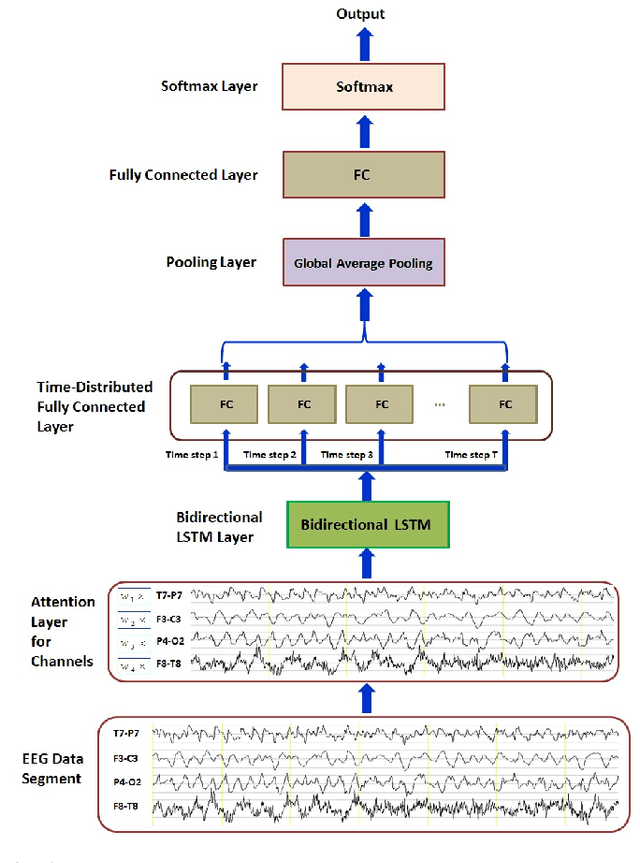

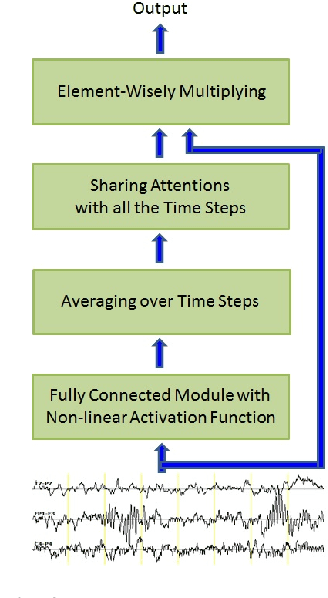

Abstract:Detecting epileptic seizure through analysis of the electroencephalography (EEG) signal becomes a standard method for the diagnosis of epilepsy. In a manual way, monitoring of long term EEG is tedious and error prone. Therefore, a reliable automatic seizure detection method is desirable. A critical challenge to automatic seizure detection is that seizure morphologies exhibit considerable variabilities. In order to capture essential seizure patterns, this paper leverages an attention mechanism and a bidirectional long short-term memory (BiLSTM) model to exploit both spatially and temporally discriminating features and account for seizure variabilities. The attention mechanism is to capture spatial features more effectively according to the contributions of brain areas to seizures. The BiLSTM model is to extract more discriminating temporal features in the forward and the backward directions. By accounting for both spatial and temporal variations of seizures, the proposed method is more robust across subjects. The testing results over the noisy real data of CHB-MIT show that the proposed method outperforms the current state-of-the-art methods. In both mixing-patients and cross-patient experiments, the average sensitivity and specificity are both higher while their corresponding standard deviations are lower than the methods in comparison.
 Add to Chrome
Add to Chrome Add to Firefox
Add to Firefox Add to Edge
Add to Edge